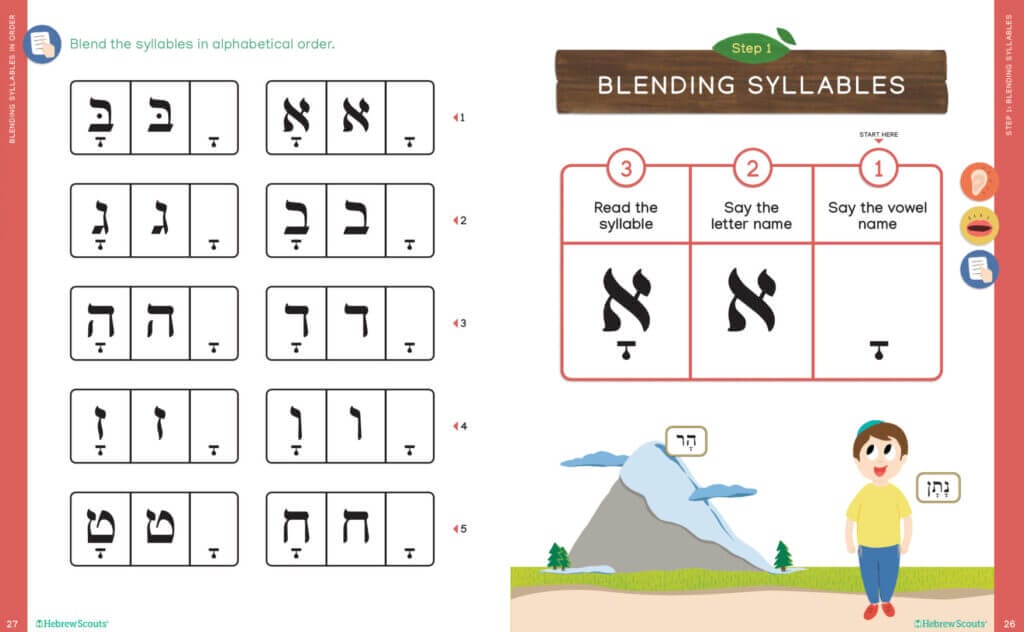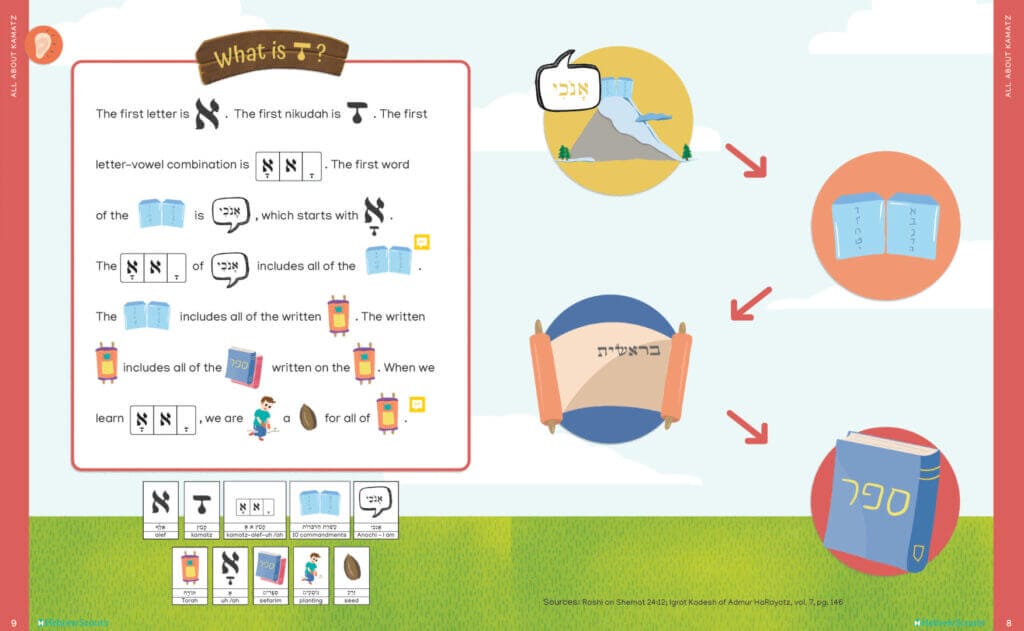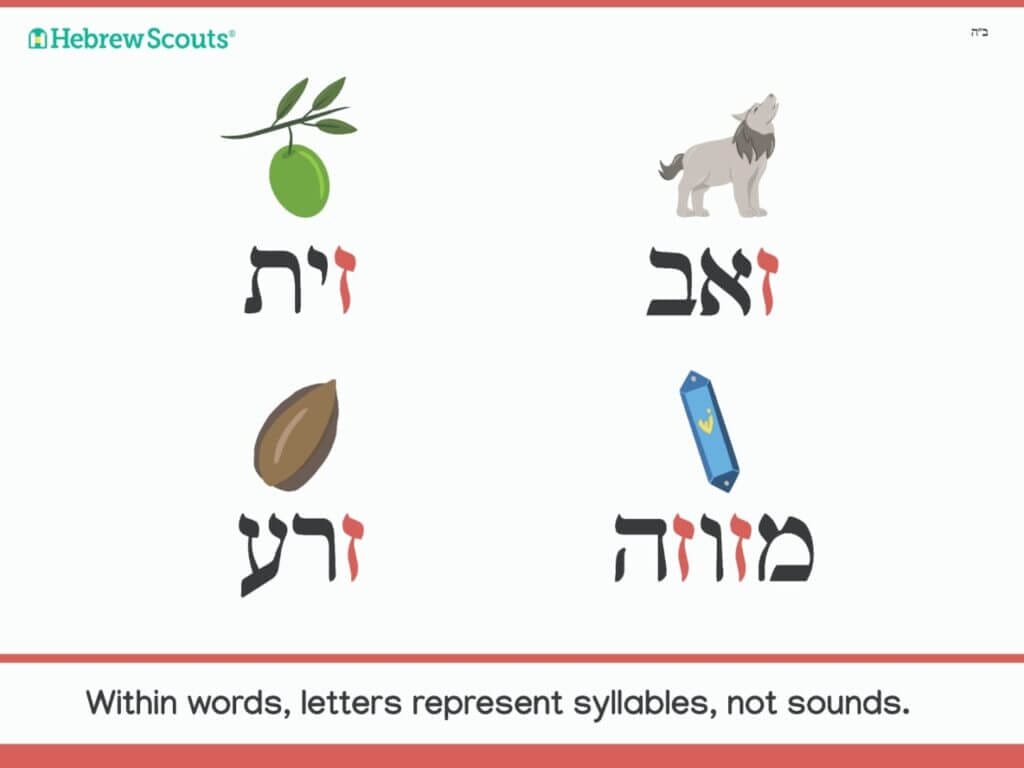Learning to read Hebrew is not just a means to an end, but serves as a spiritual experience of its own. What we call mesorah represents the way Alef Bet and Hebrew reading have been taught in our traditional communities for millenia, from Mount Sinai. This Torah-based approach is designed to convey spiritual and practical concepts in an experiential manner, while also rapidly teaching practical reading skills. We can stand firmly and confidently at the intersection of mesorah, science, and practical teaching.
There are two compelling reasons to value and promote Mesorah in teaching Alef Bet for the current generation. And it’s worthwhile to understand what the mesorah approach actually entails so its value is apparent.
Firstly, the most obvious reason to teach with a mesorah-based approach is that practically speaking, it’s simply easy. It’s easy for the student, and it’s easy for the teacher. There’s even a halachah that we must teach our children in the clearest available way.
What makes the mesorah approach so straightforward? There are numerous factors. However, we would highlight one of the cornerstones of this approach, using a pre-blended syllable as the basic unit of sound. Working with syllables is much easier than working with individual phonemes because it is a larger chunk of sound. (Fox & Routh, 1975; Goswami, 2000;Moustafa, 1995; Seymore, Duncan, & Bolik, 1999). Requiring children to blend consonants and vowels, demands more advanced phonemic awareness that isn’t necessary when working with syllables.
Secondly, another obvious reason to follow mesorah for Kriah is a spiritual one. Hebrew is not English. It is not just another language. It has a special, inherent holiness, and it is best taught in its own special way. The mesorah approach suggests certain concepts to the child as she or he learns. These concepts can be expressed explicitly to the child, but even if they are not, the messages get through via experience. By following the mesorah procedures, children draw down Hashem’s lights into their souls and into their learning spaces, laying a foundation for a faith and awe in Heaven and Torah.

What is the Mesorah approach for Kriah?
Letters Names
The shapes and names of the Alef-Bet and nikudot carry immense kedushah. Hashem used these holy letters to create the world and to write the Torah (Tikkunei Zohar, 86b:3-87a:1, Sefaria, n.d.) Our Kabbalistic traditions explain in depth how each letter and vowel stems from particular aspects of G-dliness. (Pardes Rimonim 28:1:1, Sefaria, n.d. ) Jewish oral tradition strongly values teaching children the Alef-Bet letters and the different nikudot in order and by name, as a goal in and of itself, affecting their spiritual development and connection, and not just as a means to learning how to read. Pronouncing the names of the Hebrew letters is a form of Torah study, and it has a spiritual effect.
Many English literacy educators teach letter sounds instead of letter names because many of the letter names do not support reading, to the contrary they can confuse children. Letters like f, m, n, s and x start with the sound /e/. Letters like h, w and y don’t even have the letter sounds in their names. And finally letters c and g usually are pronounced with their hard sound as in car and gum. However, this is not the case with Hebrew. The alef bet are acrophonic, meaning the letter’s name begins with the letter sound itself. Thus knowing the letters is helpful. When children begin reading syllables, they can rhyme vowel sounds with the first sounds of letter names. There is research to support that regarding Hebrew, letter names support spelling and word recognition. (PATEL et all 2002: Letter names: Effect on letter saying, spelling, and word recognition in Hebrew.)
The Alef-Bet & Nikudot Sequence
Introducing the letters and vowels in an intentional sequence, is a form of Torah study. It also connects each new learner with the untold numbers of Jewish children who learned, effectively and with love, in the exact same way back into the millennia of our history.
There are infinite lessons we can learn and share with our students as they integrate each letter in its order, in relation to the letters around it. Here’s is a famous piece of the Talmud (Masechet Shabbat 104a) that lays out ethical lessons:
Gimmel dalet means give to the poor [gemol dalim]. Why is the leg of the gimmel extended toward the dalet? Because it is the manner of one who bestows loving-kindness to pursue the poor. And why is the leg of the dalet extended toward the gimmel? It is so that a poor person will make himself available to him who wants to give him charity. And why does the dalet face away from the gimmel? It is to teach that one should give charity discreetly so that the poor person will not be embarrassed by him.


The First Syllable
Let’s take just another moment to appreciate the first vowel-letter combination: Kamatz-Alef-Ah. Far from being iconic, this syllable has its own very deep lesson for us.
Kamatz-Alef is the first syllable in the first word of the Aseret HaDibrot. It’s a philosophical principle from the Sefer Yetzirah that “the end is wedged in the beginning”. The whole Torah, oral and written, can be said to be contained in the Aseret Hadibrot, the Dibrot themselves can be “condensed” to their first two lines, and the entire thing is contained in the first syllable of the first word: Kamatz-Alef-Ah.
Rabbi Yoḥanan said that the word anokhi that begins the Ten Commandments is an abbreviation for: אֲנָא נַפְשִׁי כְּתַבִית יְהַבִית – “I myself (Hashem) wrote and gave” [ana nafshi ketivat yehavit]. (Sefaria, n.d.)
But this expression doesn’t say what Hashem gave. Was it the Torah that He gave? That’s the simple explanation. Chassidic thought suggests something deeper: that Hashem actually “wrote Himself” into the Torah and “gave” Himself through Torah, to us.
When children recite the kamatz-alef-ah, they are essentially taking a monumental step in learning Hashem’s Torah and Hashem Himself. Even if a child isn’t intellectually aware of this esoteric experience, the soul does, and the soul remembers.

There is another practical reason for teaching the syllables in order of the letters and vowels. Alef is a silent letter, so when children learn it first, it allows them to perceive the isolated vowel sound. Even if we aren’t aware of all the spiritual and practical benefits of teaching in order, it is logical to have faith in this divine system. We can rest assured.
Syllables: Bodies & Souls
Compared to nikudot, Hebrew letters are broad and visible in the Torah scroll. To the contrary, nikudot are not shown visibly. Yet we know they are there. The vowels represent something less physically evident. The vowels represent the souls of bodies. The vowels give life to a letter in the same way a soul gives life to body. Bodies without animating souls cannot accomplish anything. On the other hand, our soul needs our physical bodies to express itself. Even though we don’t usually see a soul, we know it is there.
Interestingly, in Hebrew, vowels are called תנועות which means “movements”, because they move the letters to make sounds.
When teach a child to say a syllable, we first say the vowel name, then the letter name, then the syllable. This conveys to a child that the soul precedes the body, the purpose of life is to let the soul lead the way. Kamatz- Alef-Ah holds the secret to the unique, Jewish worldview.
When we teach children to read using the “Kamatz-Alef-Ah” vowel-syllable method, we ingrain in their minds that every letter must have a vowel in order to produce a sound. This is true even for letters without nikudot. For instance, a reish at the end of the word “amar” doesn’t seem to have a vowel. Yet technically and philosophically, such consonant letters at the ends of words can be said to have a vowel: an implied resting sh’va.
Even when they eventually learn to read without printed vowel symbols, they’ll know that the words DO have vowels – they’re just not seen at the moment. Based on this understanding, fluent Hebrew readers know that letters in Hebrew words don’t represent individual consonant sounds: Bet doesn’t “say” /b/. Yet Kamatz-Bet says /ba/. Gimmel doesn’t “say” /g/. Yet Chirik-gimmel says /gi/. The letters merely represent “mouth positions” that in combination with a vowel, produce a sound. Subtly, we convey that spiritual truths do not have to be seen in order to be real. Following the mesorah isn’t just holy, but it helps to lay a long-standing foundation as to how printed Hebrew works.

We hope you’ll take every opportunity to communicate that the letters and vowels represent Torah and Hashem. The youngest child, just by studying the letter Alef, is learning Torah! That’s something to celebrate!





